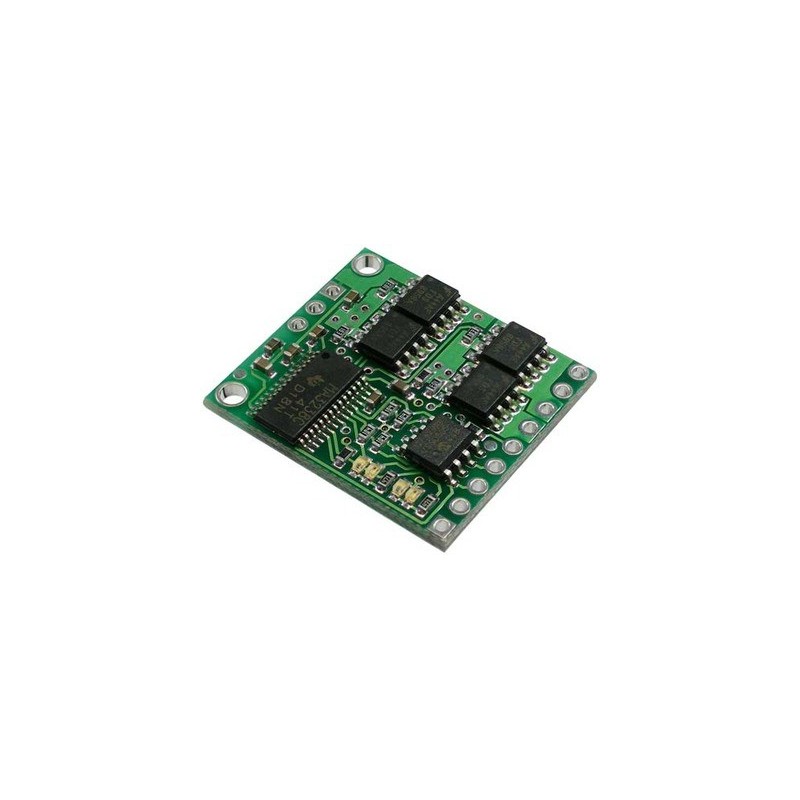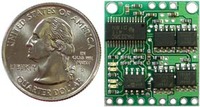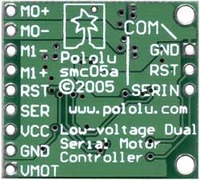

Pololu Low-Voltage Dual Serial Motor Controller
Frustrated by those cheap, low-voltage motors that require too much current? Here’s the answer: a low-voltage motor controller designed specifically for those toy motors. With all of the convenience of the Pololu dual serial motor controllers and the added ability to deliver 5 amps per motor with no minimum motor voltage, this dual serial motor controller has you covered.
 |
This low-voltage version of our dual serial motor controller (DSMC) is designed specifically for high-performance, low-voltage toy motors that run on 1.5 - 6 V. Because they run at lower voltages, these motors have higher current requirements, making them difficult to control since most integrated motor drivers are designed either for low-current, low voltage motors (such as those in CD players or cameras) or for higher-voltage motors that run at 6 volts or more. With this latest motor controller, you can consider a whole new range of motors for your next project.
Because of the unique design of the low-voltage motor controller, there is no minimum motor supply voltage, meaning that a motor can be run off of a single cell until it is completely discharged. In a typical application, two to five Ni-Cd or Ni-MH cells can be used throughout their discharge cycle. The motor controller can deliver up to 5 A continuously to each channel, without a heat sink, and like our other dual serial motor controllers, the two output channels can be coupled to deliver up to 10 A to a single load. Since many small Mabuchi motors (such as those used in the Tamiya gearboxes) have stall currents in the 2 - 4 A range, you can drive them to the limits of their performance.
 |
In addition to the motor supply, the controller requires an independent 3.0 - 5.5 V logic supply, which can be higher or lower than the motor supply voltage. This can be useful if you have 3 V motors that you would like to run off of two or three cells but have 5 V logic. If you do have a single supply that satisfies both requirements (which would typically mean 3 or 4 cells), the motor controller can be powered off of a single supply. Each motor has a corresponding pair of LEDs that light up without the motor supply to let you troubleshoot your code without your robot driving away.
The 9-pin module is pin-compatible and code-compatible with our micro dual serial motor controller, making it easy to upgrade your existing robot to higher performance. The low-voltage motor controller shares all of the features of the micro motor controller except for coasting: setting speeds of 0 in forward or reverse will result in braking.
Please note that the low-voltage motor controller can become very hot during operation; observe proper precautions around a running unit. A heatsink can improve performance, but it is not required. The motor controller does not feature over-current or over-temperature shutdown. Applying reverse battery polarity or attempting to draw too much current will cause permanent damage to the motor controller.
For high-current applications, make sure to use the thickest and shortest wires possible. Make sure your motors have 0.1 uF capacitors installed across their leads to limit noise and interference with your other electronics. Make sure that your battery can deliver the current that you attempt to draw: typically, you should have at least 1 amp-hour of capacity per 10 amps you draw (which would give you about five minutes of operating time).
Note: This product no longer ships with a printed user’s manual. The user’s manual can be downloaded as a pdf from the resources tab of this product page.
 |
Tamiya 70144 Ball Caster Kit (2 casters) |
 |
Tamiya 70097 Twin-Motor Gearbox Kit |
 |
Tamiya 70101 Truck Tire Set (4 tires) |
Data sheet
Manufacturer BTC Korporacja sp. z o. o. Lwowska 5 05-120 Legionowo Poland sprzedaz@kamami.pl 22 767 36 20
Responsible person BTC Korporacja sp. z o. o. Lwowska 5 05-120 Legionowo Poland sprzedaz@kamami.pl 22 767 36 20
3-channel brush motor controller module with PWM signal mixing function. It allows you to control three DC motors with a current consumption of up to 3 A per channel
Dual DC motor controller designed for Raspberry Pi, which enables the engine to be supplied with voltage in the 4.5-28V range and power consumption in continuous operation of 2.6A (5A in peak) of two DC motors. Pololu 2762
Brushless motor driver module (ESC regulator) with current efficiency up to 35 A
DC motor driver that allows you to control the movement of two drives using the I2C interface. Board with connectors for self-assembly. Pololu 5046
No product available!
A compact stepper motor controller with the TMC2209 system with an operating voltage from 4.75 to 28 V. It offers smooth, quiet operation, high efficiency, various operating modes and easy configuration. It is controlled via the STEP/DIR interface and is an ideal solution for 3D printers and similar applications. BIGTREETECH TMC2209 V1.3
DC motor driver that allows you to control the movement of two drives using the I2C interface. Board with soldered connectors. Pololu 5051
No product available!
DC motor driver module with two channels, dedicated to use in modeling. It can be controlled by an RC transmitter and uses the PPM signal. DFRobot DFR0513
This powerful motor controller makes closed-loop speed or position (but not both!) control of a brushed DC motor easy, with quick configuration over USB using our free software. It supports five control interfaces: USB, TTL serial, I²C, analog voltage (potentiometer), and hobby radio control (RC).
Pololu High-Power Motor Driver 24v12
Two axis stepper motor driver expansion board based on the L6470 for STM32 Nucleo
A module with a two-channel DC motor driver based on the TB6612FNG system. Designed for Wemos D1 Mini
Compact stepper motor controller with the TMC2208 system with operating voltage from 4 to 35 V. It offers smooth, quiet operation, high efficiency, various operating modes and easy configuration. It is controlled via the STEP/DIR interface and is an ideal solution for 3D printers and similar applications
No product available!
Module of a 4-channel driver of DC motors with RP2040 microcontroller. It allows the connection of encoders and is equipped with a QW/ST connector. Pimoroni PIM636
Module with DC motor driver DRV8874. It can work with motors supplied with the voltage from 4.5 to 37 V and current consumption up to 2.1 A. Pololu 4035
Pololu G2 24v12 High Power is a miniature DC motor controller. Driver\'s power supply: 6.5 ... 30V. Current capacity of the module: 12A. The module has protection against back voltage and overvoltage. Pololu 1364
Atmel ATmega32U4 microcontroller comes preloaded with an Arduino-compatible bootloader, and the board includes dual motor drivers that can deliver 1.7 A per channel to two brushed DC motors. Pololu 3119

Pololu Low-Voltage Dual Serial Motor Controller
